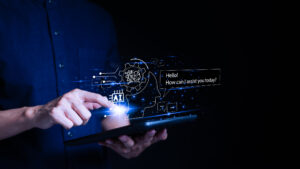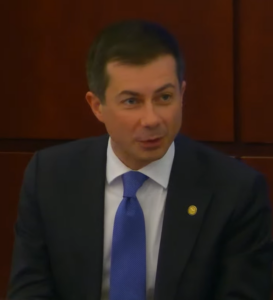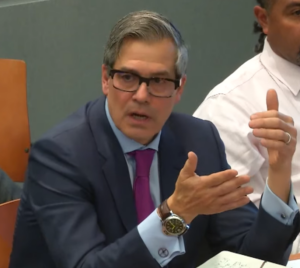
New USDOT committee to focus on automated driving, AI safety
By onTechnology
Automated driving and artificial intelligence (AI) emerged Thursday as the top two topics discussed by the first meeting of the U.S. Department of Transportation (USDOT)’s Transforming Transportation Advisory Committee (TTAC).
The 27 members spend five hours discussing their views on the current state of vehicle and transportation infrastructure and system technologies and innovation in meeting USDOT’s goal of zero traffic deaths.
The members come from backgrounds in academia, think tanks, and the public and private sectors in automation, cybersecurity, safety, accessibility, law, government, entrepreneurship, privacy, equity, and more. TTAC’s purpose is to consider issues related to safe, secure, equitable, environmentally friendly, and accessible deployment and cross-modal integration of emerging technologies, including automation applications, according to USDOT.
“Part of how I think about innovation and technology and its importance in transportation is to think of the establishing shot of any show or being set in a different time period than ours,” said U.S. Transportation Secretary Pete Buttigieg. “If you think about it, more than anything else — more than the architecture, buildings [and] more than the costumes people are wearing — the thing that lets you know what timeline you’re in is usually the transportation.
“The pace of change in our transportation helps us mark, not just the development of transportation, but modernity itself so much so that we can actually identify to the precision of about a decade where we are in the 20th century just by looking at the cars… I think that says a lot about where the innovation specifically around transportation sits in its importance in our lives.”
Although transportation innovations aren’t always vehicle-related, he added, while noting that the most transformative transportation technology in the last decade has been the smartphone.
The USDOT mission, which Buttigieg said TTAC will help meet, is “build, run, and protect.”
“We build infrastructure, we run systems, and we protect people,” he said. “Protecting people is our safety mission. It’s our core mission… [infrastructure] has to be shaped by smart technology and innovation strategies… that’s where we need your help.”
Buttigieg added that safety, climate, equity, and jobs will get easier or harder “depending on how much we can get our arms around the moment that we’re in.”
“Whether it’s supporting the development of new technologies, whether it’s ensuring those technologies are safe, whether it’s using innovation to build smarter and better and cheaper than we have,” he said.
Following President Joe Biden’s October 2023 executive order to AI developers and all U.S. government departments to ensure AI developments are safe, secure, and trustworthy is also a goal of the TTAC, Buttigieg said.
City of Phoenix Mayor Kate Gallego, and TTAC chair, said Phoenix and Chandler have the largest autonomous vehicle zones in the world, which has led to a lot of discussion and planning on city redesign, she said.
“Interoperability of technologies and planning for these technologies in a systems approach — that is, really I think, a challenge, but there’s also opportunity there,” Gallego said. “As we start to look at all of the data available from phones, vehicles, [and] sensors, we know that there’s a richness of this data that can help us in terms of creating these better outcomes for safety, efficiency, and emissions.”
Alliance for Automotive Innovation (Auto Innovators) President and CEO John Bozzella said rather than thinking from technology forward, technological innovation needs to be looked at from the consumer back.
“If you think from the consumer back… we need to be very thoughtful about how we make sure consumers understand the benefits of technology and the opportunities to increase safety, reduce fatalities, create more opportunities and access for people who don’t currently have access… and to reduce carbon emissions. We have to focus on the benefits and we have to focus on acceptance.”
In a similar vein, Consumer Reports Vehicle Technology Associate Director Kelly Funkhouser said the group and USDOT need to make sure consumers aren’t “set up to fail” with new technologies.
“We hear a lot of the stories, we see the headlines out there, of the crashes that are happening because of some of these systems out there,” she said. “We have this opportunity to talk about what leads to some of those when all this technology has promise and we’re carrying all the potential benefits to improve safety.
“We want to make sure that we can actually achieve safety in a real way and also have it help consumers and not put them in a position where they are… becoming over-reliant or complacent on some of these technologies.”
Southwest Research Institute Intelligent Systems Vice President Steve Dellenback and Future of Privacy Forum U.S. Policy Vice President Amie Stepanovich and Bozzella noted the importance of cybersecurity and data security, such as personally identifiable information (PII), in the discussions and planning moving forward.
Other members said they think federal advanced driver assistance system (ADAS) safety standards and autonomous vehicle (AV) company regulations are needed.
The committee touched on workforce issues and job displacement as well with the overarching consensus being that a solution would be reskilling opportunities available to workers whose jobs may be replaced by automated technologies. The group, overall, also thought if anything, automation could fill job vacancy gaps in transportation and would make current ones more efficient rather than fully taking over.
Other options mentioned were federally funded training programs and educating students as young as elementary grades for jobs related to advanced and automated technologies.
Stepanovich that the definition of “workforce” will need to be looked at moving forward as vehicles transform from machines to computers.
The committee didn’t schedule its next meeting. Moving forward, it does plan to create subcommittees to focus on key areas such as safety and AI.
Images
Featured image: Illustration of AI in use. (Credit: Supatman/iStock)
City of Phoenix Mayor and TTAC Chair Kate Gallego speaks during the first meeting of the committee held on Jan. 18, 2024 while Vice Chair Bryant Walker Smith (left) and U.S. Transportation Secretary Pete Buttigieg look on. (YouTube screenshot)


